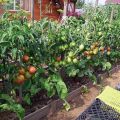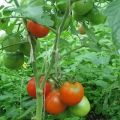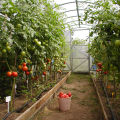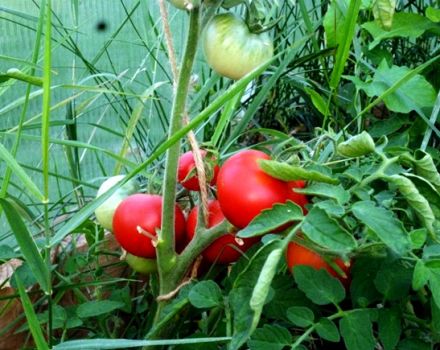Growing tomatoes in buckets in the open field and in the greenhouse
Many experienced gardeners grow tomatoes in buckets and are happy with their results. There are many positive aspects to this method of growing tomatoes, which make it easier to care for and take a high-quality, numerous crop.
Method advantages
Growing tomatoes in buckets is easy.
A container with a seedling feels great in the open field and in the greenhouse. Gardeners consider the following points to be advantages:
- the water and the earth itself in the bucket quickly heats up, as a result, the growth and development of the bush is accelerated;
- when watering, water does not spread over the soil surface, but penetrates directly to the roots;
- fertilizers are fully supplied to the root system;
- you can renew the land annually;
- the risk of spreading infection decreases;
- plantings take up little space and can be moved;
- during heavy, prolonged rains, containers can be placed under the roof;
- no need to fight weeds;
- tomatoes begin to ripen two or even three weeks earlier.
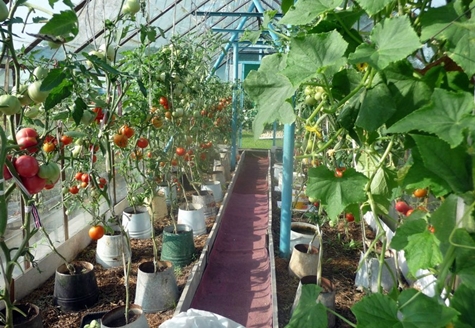
On the grown tomato bushes, juicy, fleshy large fruits are formed, with a dense skin that protects against cracking. The container with seedlings can be kept both in the greenhouse and on ordinary garden beds.
To grow tomatoes in buckets, you need to choose the right variety. This method is suitable for planting hybrids and varieties of tomatoes, which have a compact root system and slightly leafy branches.
In the reviews, only the positive aspects of such cultivation in a bucket are noted: “Many years ago I began to plant tomato bushes in buckets. It all started by chance. There were extra seedlings left, which it was a pity to throw away. I planted one seedling at a time in old, leaky buckets filled with soil from the garden beds. I placed the seedlings in a greenhouse, away from the beds.
It was a surprise that greenhouse tomatoes in buckets began to ripen 2.5 weeks earlier than the rest of the plantings. Their stem was strong, and the fruits were large and very tasty.
The next year, I planted several shoots separately again. The result was again pleasing with a delicious harvest. And I noticed that the more leaky the bucket, the more harvest we managed to remove! Now I plant only in separate containers, care is minimal, I have never had any illnesses, and all family members like the taste of tomatoes! "
Growing technology
You can grow tomatoes in both metal and plastic buckets with a volume of at least 10 liters. You can take old, deformed containers. It must be remembered that the black and dark brown color of the container will heat up more in the sun, which will have a bad effect on the plant. Therefore, buckets of this color should be wrapped in light-colored cloth.
Numerous holes are made at the bottom of the prepared container. Excessive moisture will escape from the holes made.One sprout is planted in each bucket.
In the last days of October, a mixture of humus with wood ash is poured into a bucket and watered. The ideal option would be to take the land where the cucumber beds used to grow.
Buckets are arranged in neat rows in the greenhouse or dug into the ground in a garden plot. It is recommended to keep snow in the buckets throughout the winter. It impregnates the earth well.
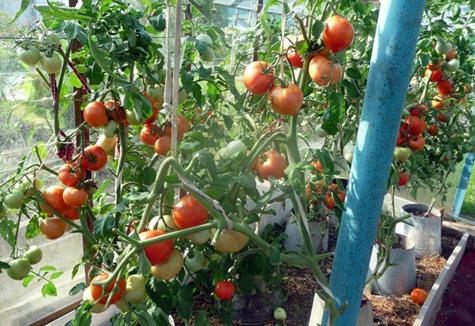
Snow melts in buckets much faster than in the beds. In addition, the ground warms up faster, so planting seedlings can be done much earlier.
Some gardeners come up with other ways to grow tomatoes in buckets in a greenhouse. Growing tomatoes with the root system upwards is popular. To do this, pick up a bucket, make a hole at the base through which the seedling is pulled. The roots are covered with earth and compacted.
This method allows you not to resort to weeding and loosening during cultivation. The bucket can be hung anywhere, thus saving space that is always in short supply.
Care rules
Caring for bucket tomatoes involves the usual steps.
- Water should be done as the soil dries up. If the buckets are dug into the ground, then you can water the space outside the container. Avoid getting water on the green part of the plants.
- The room in the greenhouse must be ventilated and the temperature and humidity must be monitored. Air humidity is not more than 70%, temperature is not higher than 30 degrees.
- Weeds must be removed in a timely manner.
- Many varieties of tomatoes require pinching during care.
- During the entire growing season, fertilizer must be applied at least three times.
It is imperative to carry out hilling. The procedure strengthens the root system, the stem becomes powerful, and the leaves are rich green. Since the area around the bush is small, the work will take a little time.
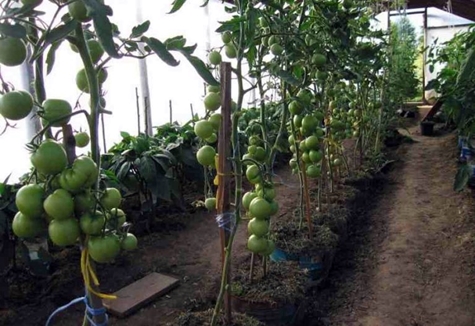
Mulching is recommended, although the seedlings in buckets do not need this step as much. But still, mulch can reduce the risk of spreading infection, attack of pests, weeds will not appear, and moisture will not evaporate. You can pick up peat, chopped meadow grass, sawdust, straw as mulch.
To prevent a dry crust from forming on the surface of the soil, it is useful to loosen the soil, especially after watering or rains if tomatoes are grown outdoors. Due to loosening, trace elements and oxygen penetrate into the plant faster.
Growing tomatoes in buckets is not complete without the pinching procedure. Pickling is necessary to increase yields. Removing the side, extra branches, contributes to the fact that the plant directs all the forces to the formation of fruits, and not to the growth of leaves and stems. The procedure is most often needed by tall varieties of tomatoes.
If the stem stretches high up, then you need to install a peg to which the bush is tied. Sometimes undersized bushes need a garter. Placing a lot of fruit on the branches can cause the stem to break. Thanks to the garter, light and air can freely flow to all parts of the plant.
Suitable varieties
You can plant any variety of tomatoes in a bucket, for example, you can try the following types.
The Wonder of the Earth variety belongs to the early maturing, indeterminate tomato groups... The stem can stretch up to 170 cm. The bright pink color of the fruits in buckets begins to ripen after 90 days. Weight can reach 500 g. The harvested crop can be stored for a long time, does not crack.
The bush of the Canadian giant variety can grow up to 150 cm, so you need to tie it up. The red-orange fruits can weigh about 350 g, the shape is slightly flattened. The pulp is sweet with a pleasant sourness.
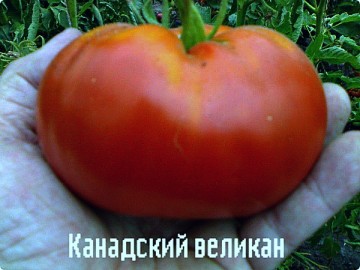
Argentinean cream is characterized by a compact bush that does not exceed 40 cm in height and a high yield. The shape of the tomatoes is oblong with a spout at the base. Weight about 80 g. Tomatoes begin to blush after 90 days.
The sorcerer is characterized by early ripening of fruits, approximately 95 days. The stem stretches up to 50 cm, the branches are medium-leafy. There are 5 fruits on the brush, which, when ripe, acquire a red tint. Weight approx. 150 g.
The gardener's dream belongs to the determinant varieties. The height of the bush is only 65 cm. The round-shaped fruits have an even, glossy, red surface. The average weight is 160 g.

Variety Miner Slava, planted in buckets, has a powerful stem, large, sweet tomatoes, weighing about 250 g and early ripening. Long-term fruiting. Tomatoes are oval in shape and turn red when ripe. The fruit tastes juicy and sweet.


